Fez
“So now we are going to Fez! Inshallah!” announces our guide. “Inshallah” echo the occupants of the bus. It is a long drive southwards to Fez. Over four hours. But the minibus is comfortable and the regular cheery interjections about the landscape, history, and other things Moroccan hamper any lapses into torpor. I spot many cattle egrets en route, mostly in small groups or around a cow or two (hence the name). Some poles with the imperious stork atop. Lot of pigeons, doves, magpies. Stop at a viewpoint over a reservoir surrounded by low creamy coloured clay hills. A chap is selling pomegranate juice there directly from the crusher. Doing a flourishing business. Refreshing nectar. Souvenirs, such as straw hats and mats and baskets are strewn about for sale and a load of gourds are suspended from a bamboo roof.
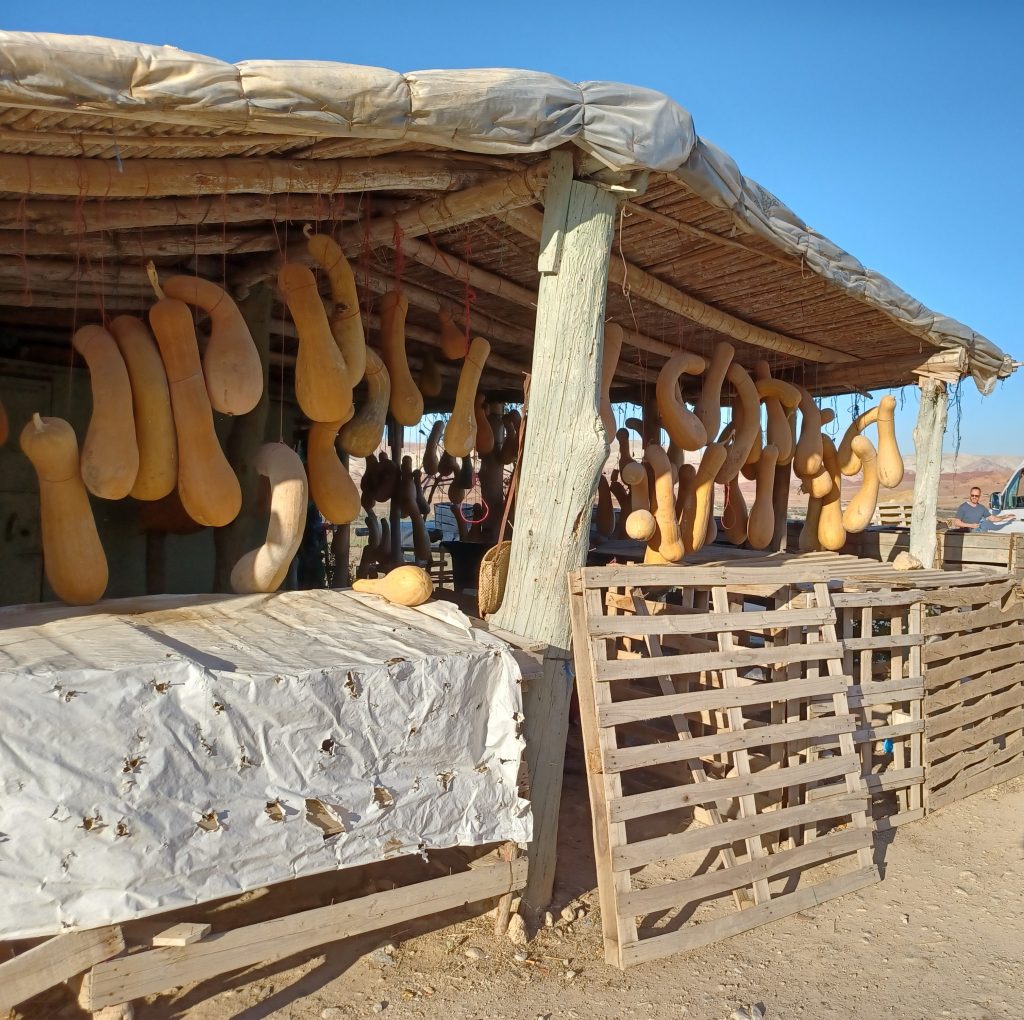
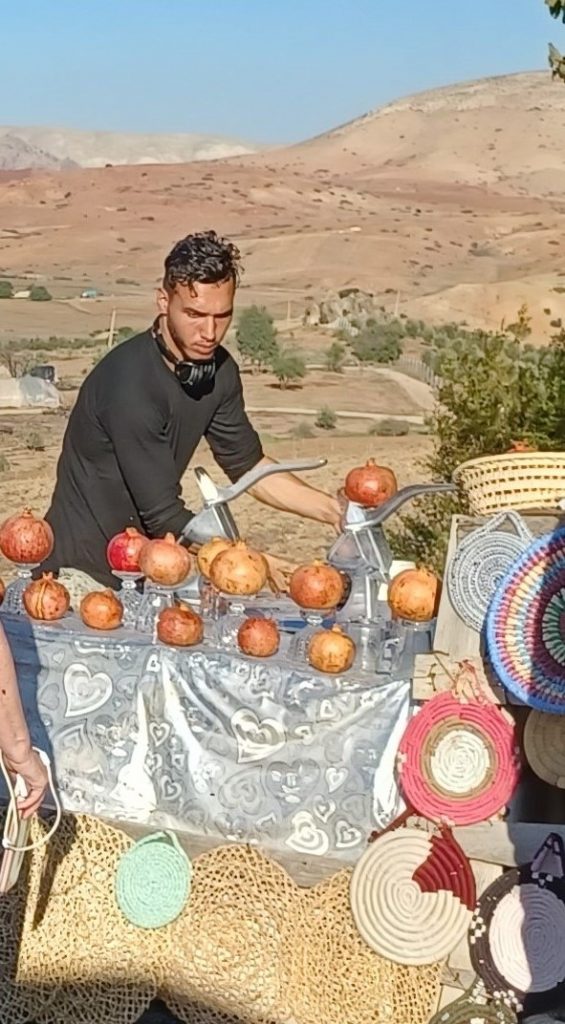
Royal Palace, Fez
Earlyish morning. The Royal Palace is the first stop. Built in the 13th century. We stand in a huge square named the Place des Alaouites or Alawi Square with our local guide. Many tour groups are ogling at the newish palace gates, built by King Hassan II in 1968. There are seven of them. Very ornate: gilt covered bronze with geometric patterns on them. Around the horseshoe shaped arches are those beautiful zellij tiles. The guide tells us that the five elements of decoration on the Palace and elsewhere on old buildings – many now converted into hotels and restaurants – are 1) bronze, 2) cedar wood, 3) zellij tiles, 4) stucco, and 5) Carrara marble.
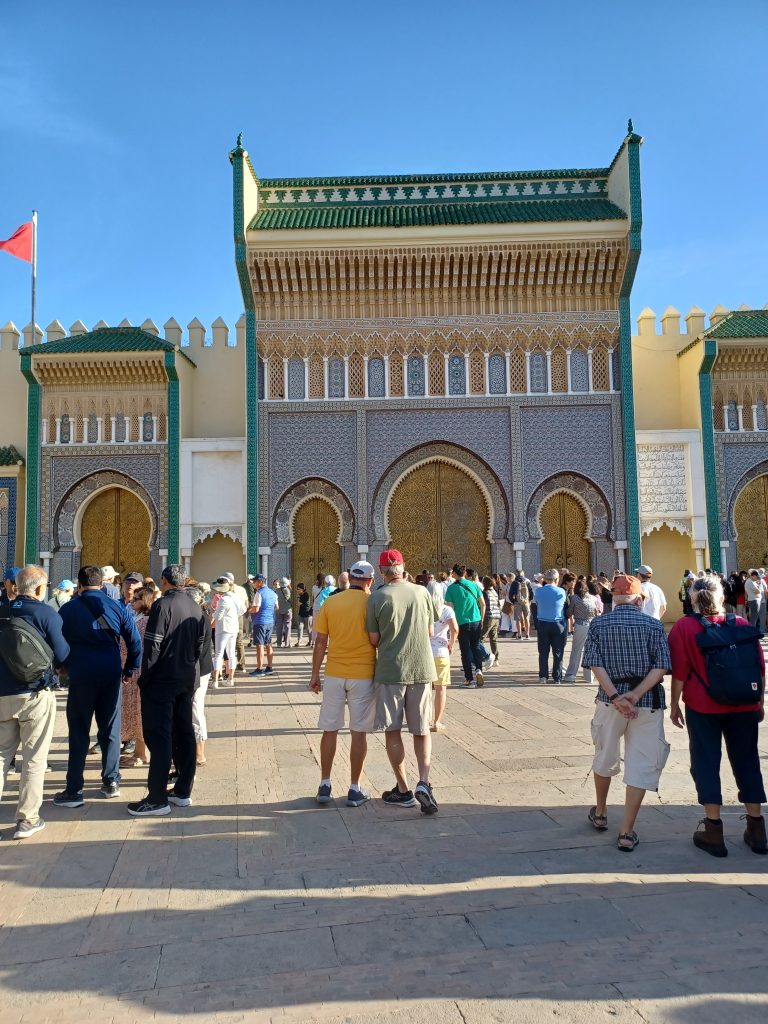
The Moroccan flag waves atop one gate. “The red colour of the flag represents blood”, we are informed, “the green of the star is for Islam.” And the five points of the star, which sits in the middle “are for the five pillars of Islam”. The gates are all that tourists are permitted to see as the Palace is used by the Moroccan monarch, albeit his main palace is in the capital, Rabat.
The Mellah, Jewish Quarter
We pass next through the old Jewish quarter, the ‘Mellah’, alongside the Royal Palace. The Mellah was created in the 15th century by the then Sultan and, according to our guide, its location shows the significance of the Jewish population to Morocco’s development, particularly in terms of trade and commerce. There were once as many as a quarter of a million Jews living here. The Muslims protected religious minorities, not as happened in Spain, the Jews being kicked out in 1492 when the Christians took over.
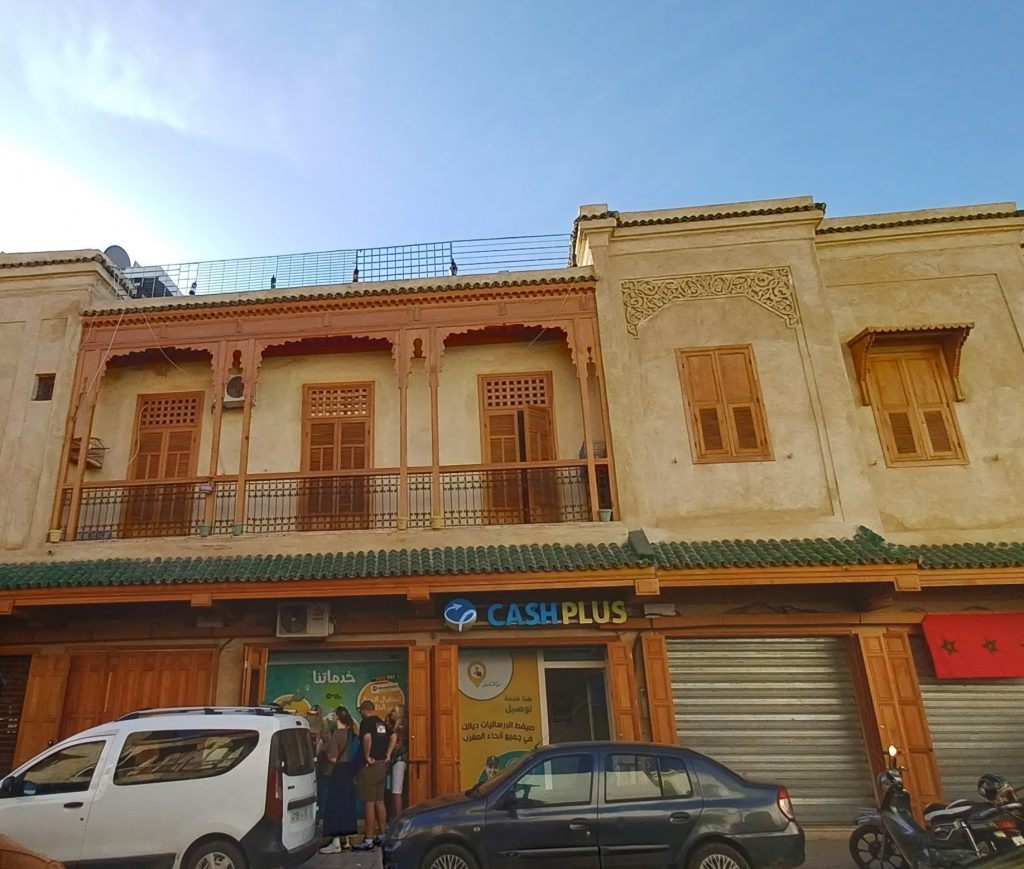
All the Jews are gone now, having left in 1948 to Israel and elsewhere, but some still own their handsome houses with their cedar wood balconies. UNESCO has restored some of these, apparently.
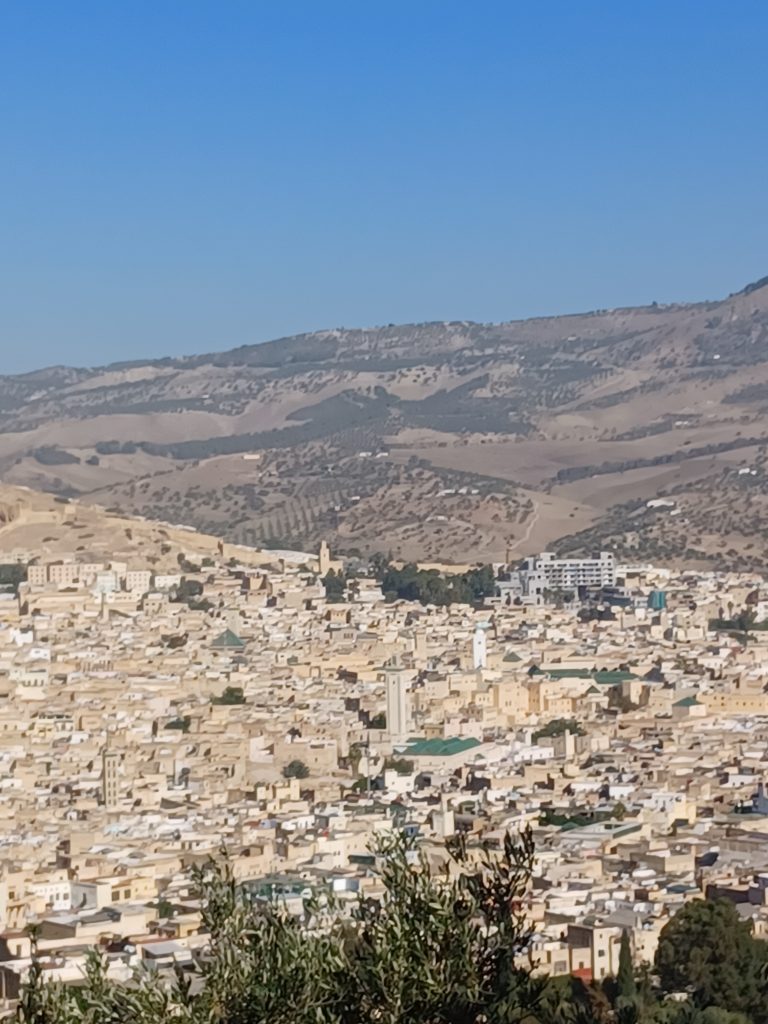
Around Fez are several kasbahs built to protect the city and perched on higher ground. These were added after the walls of the Medina in order to keep an eye on incomings and outgoings. We drive to a kasbah to look down upon Fez from one of these vantage points. “There are three parts to Fez”, our guide tells us: “This part is the new” and he waves to the left, “13th century in the middle and 9th century to the right”. “We have the oldest university in the world in Fez”, says he. “Best university in Morocco. Good reputation”. This, the Sidi Mohamed Ben Abdellah University, is placed within the top 1000 universities globally.
At the viewpoint a stash of bright red fezzes with their black tassels, the type Tommy Cooper used to wear, are for sale. Some locals still wear them too. Our American friend is unable to resist. Buys a couple.
Art de Poterie workshops
Near the kasbah is a ceramic workshop towards which we are now beckoned. This should be interesting. Outside a man, knee deep in clay, is endeavouring to rid said clay of air bubbles to make it consistent throughout. Hot and messy work. He doesn’t seem to mind posing for photographs. Doubtless a considerable relief to stand upright for a few moments. Then we enter the precincts of the Art de Poterie workshops where some of Morocco’s finest craftsmen are at work.
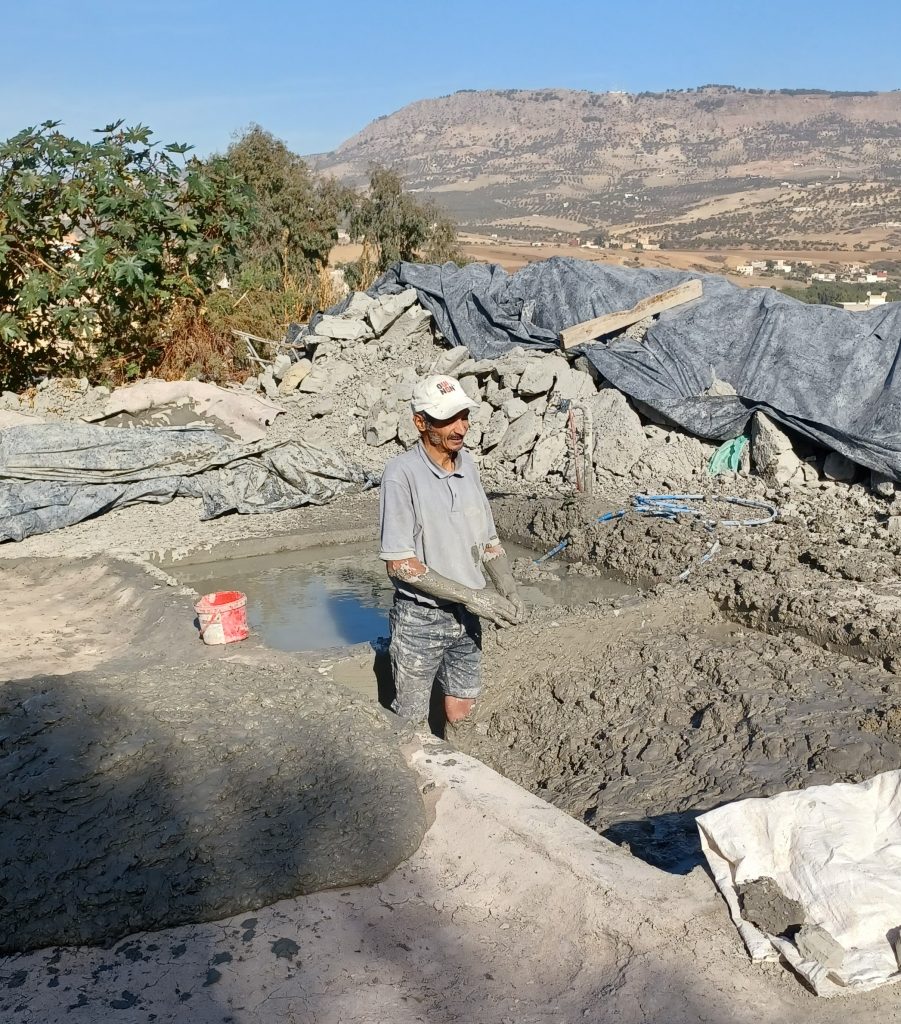
One is throwing a largish pot upon his potter’s wheel; another is chipping away at a tiny mosaic piece. These pieces will later be placed on wall panels or atop small tables or other furnishings. One chap, totally absorbed, is fitting some around a mirror. The showroom is full of exquisite goods, ornamented household wares and artworks, which we are invited to purchase.
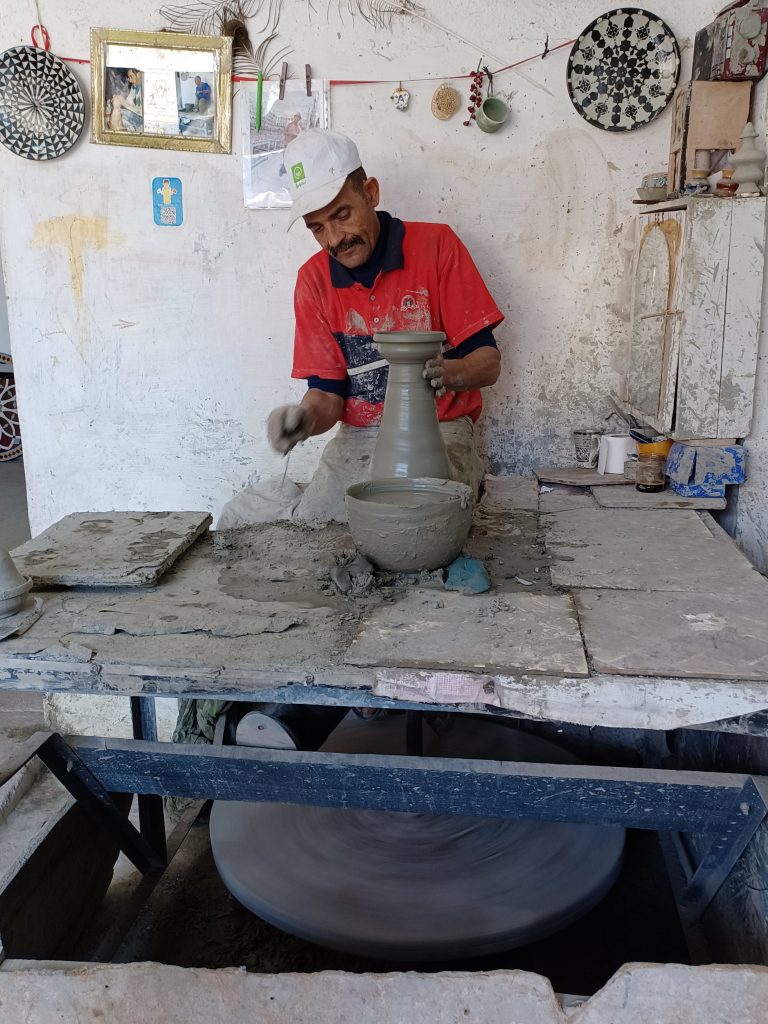
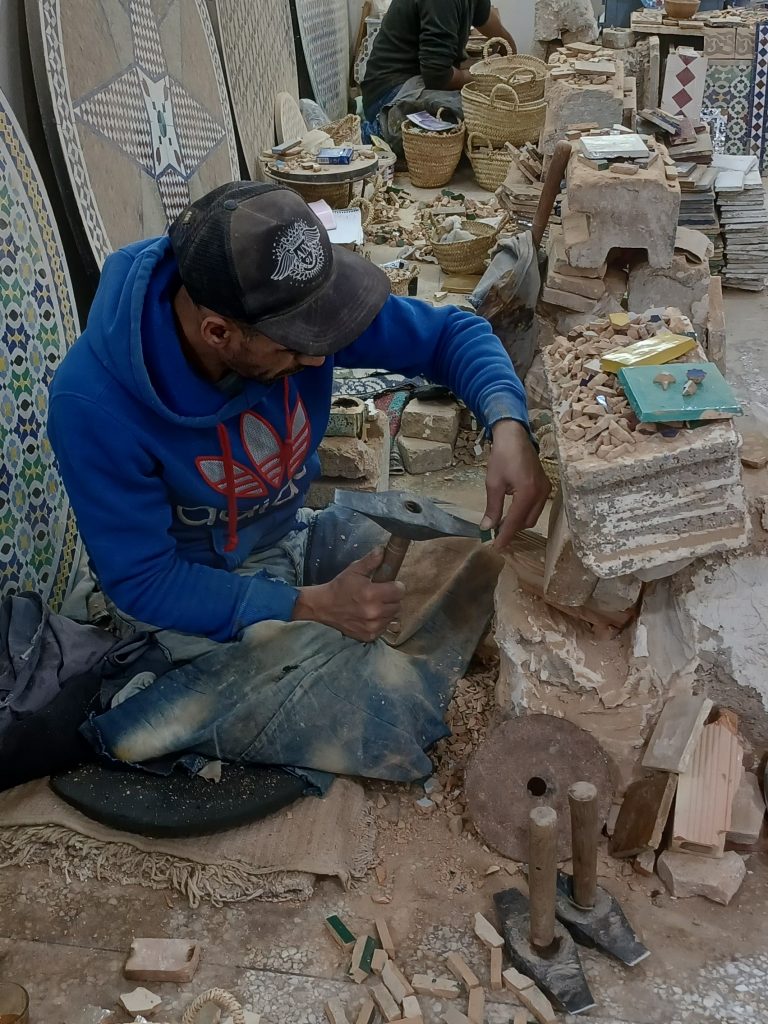
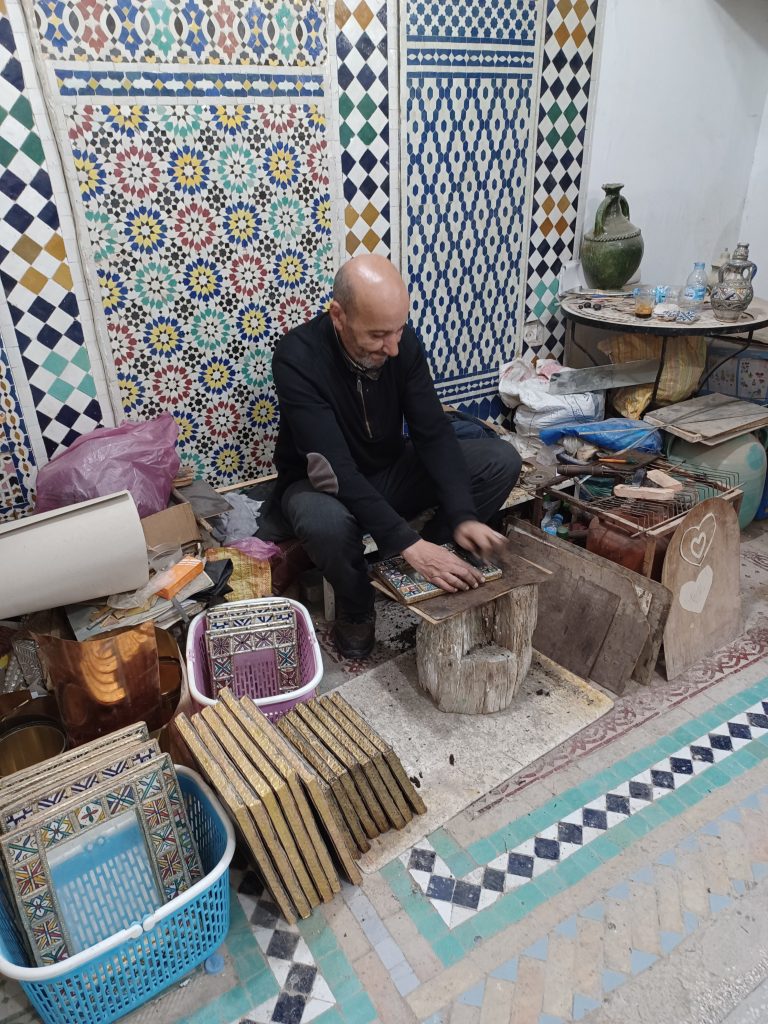
Fez Medina
Now time to head to the medieval city and enter the old medina, another fascinating frenetic place. Free from motor vehicles and a UNESCO World Heritage Site, Fez has been the capital of Morocco for much of the country’s history, being situated on a major Saharan trade route between the Mediterranean and West Africa. Its capital status was usurped by other cities due, among other reasons, to its less than convivial climate, according to our guide. It can even snow in Fez. Fez was the capital city when the French took over in 1912. They chose Rabat as the new capital, but Fez is still regarded as Morocco´s spiritual and cultural heart. Inside the medina’s walls is a maze of alleyways, some even spindlier than those in Marrakech. 9,000 of them along with 30,000 shops crammed full of goods. A place easy to lose oneself in after a few seconds. Impossible not to in fact.
A different local guide, authoritative sort of chap in chocolate coloured djellaba, weaves his way up these claustrophobic alleys, shops displaying wares each side. He seems to know everyone: “Assalamu Alaikum.” At every junction he halts to round up recalcitrant members of the group before leading the way through the labyrinth like a homing pigeon. Bunches of dyed wool are hanging down over passers-by, men bashing bronzeware, budgerigars and carolling canaries in cages. Men shove past pushing those metal trolleys, such a familiar sight in Marrakech. “Balak, balak”! Watch out! Donkeys, alley cats, wooden crafts, ceramics, fish stalls, and a cow’s head squatting on the butcher’s counter ready to be sliced up, all accompanied by the pungent reek of the tanneries, for which Fez is famous.
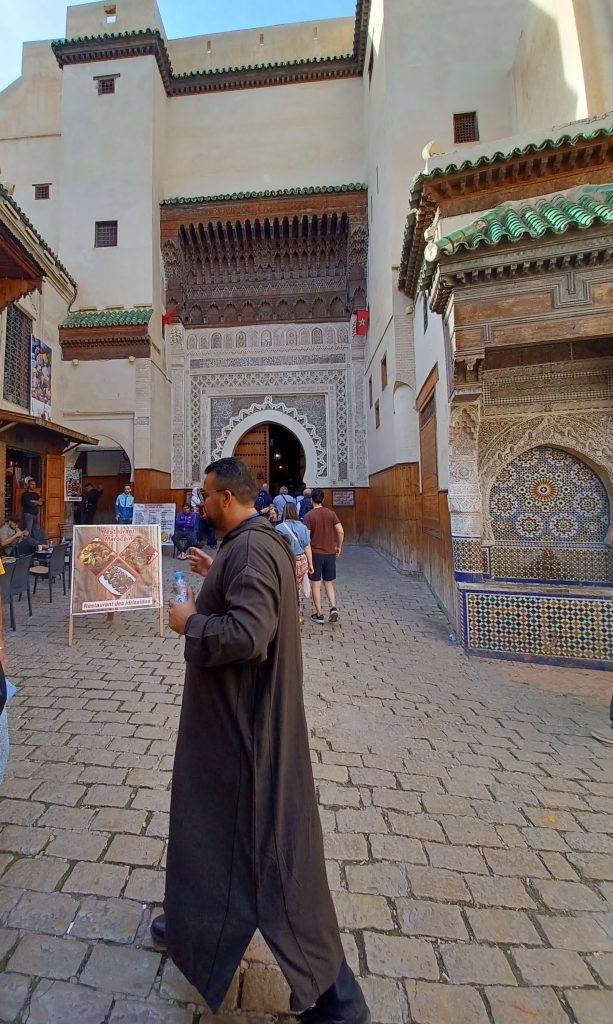
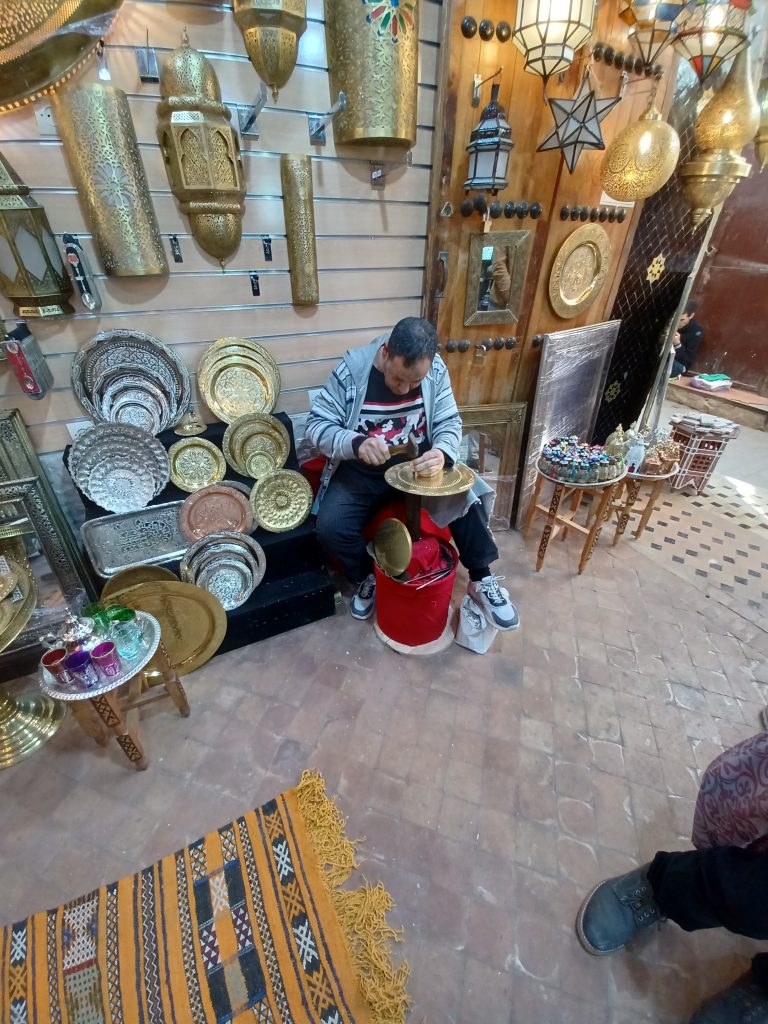
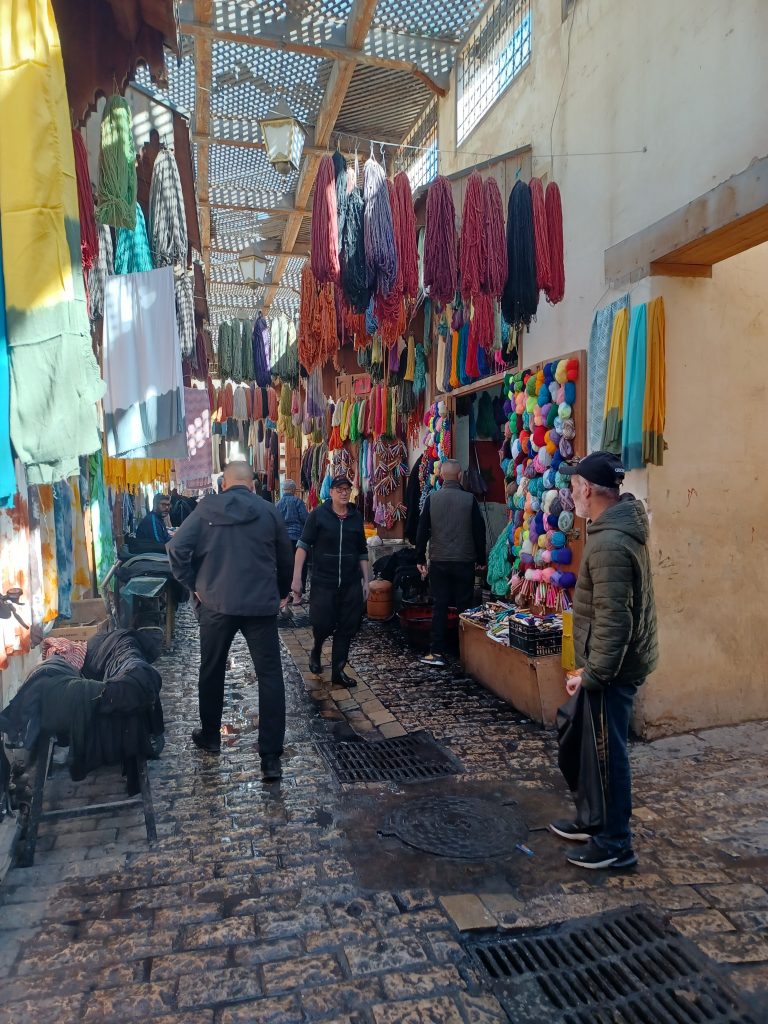
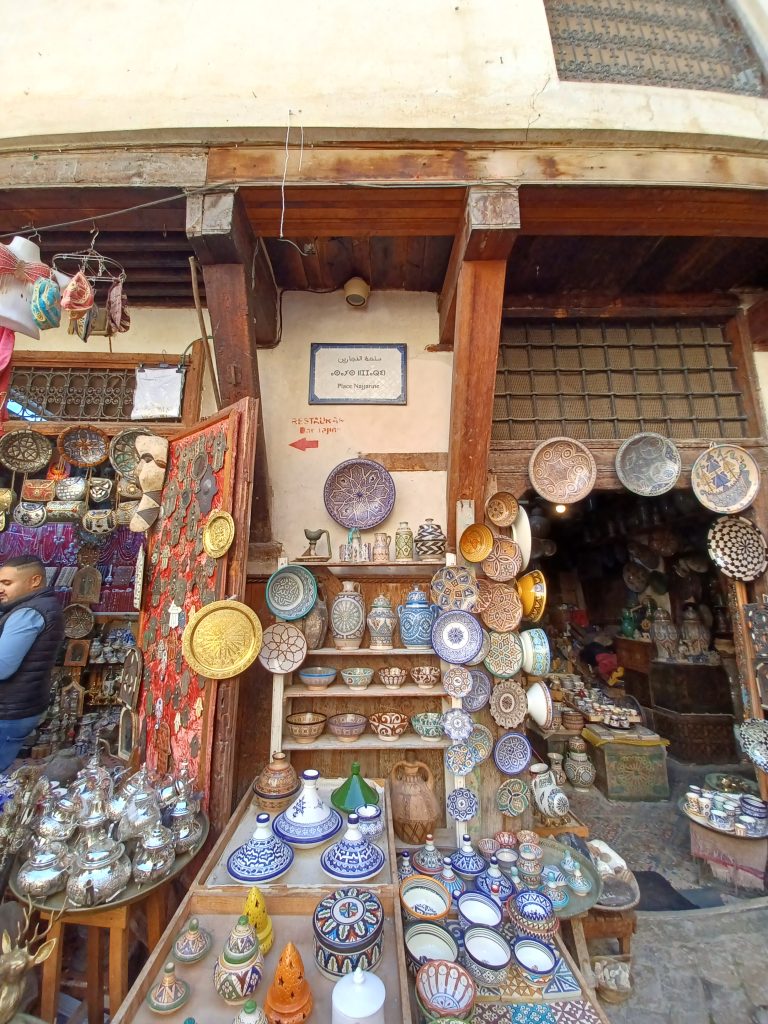
Follow the odour and arrive in a shop which overlooks the Chouara Tannery, which is, apparently, the oldest in the world. Medieval. Presented with a sprig of mint to counteract the whiff. Men are standing in the rectangular vats soaking the hides of animals in a whitish mix of quicklime, cow urine and water. This mix removes any hair or fleshy bits remaining on the hides. Other vats contain pigeon poop (which contains ammonia I understand) with water, which softens the leather, especially after hours treading it with bare feet. After that the hides are plunged into the roundish dying vats: “the red is from poppies, orange from henna, blue from indigo, yellow from saffron”. Palettes of many colours. Then hung out to dry. This process has been going on for centuries.
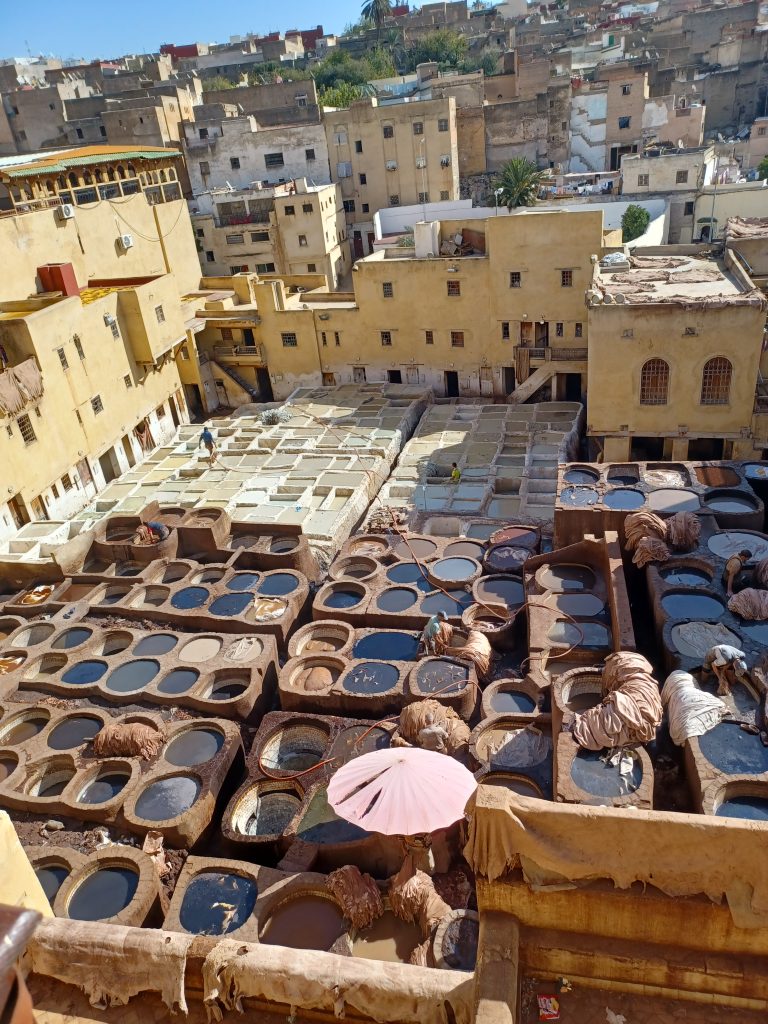
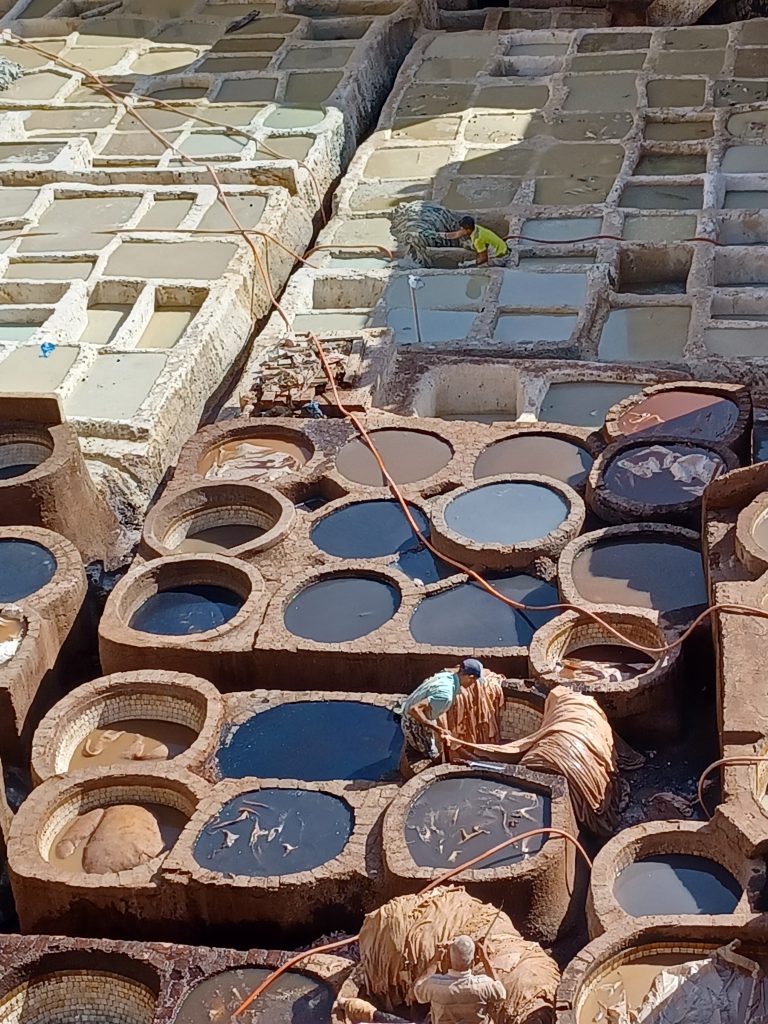
Much exhortation from the merchants for us to purchase the products of the tannery: leather pouffes, jackets, bags, wallets at inflated prices. Our American friend does his bit for the Moroccan economy – again – and purchases a pouffe. There are many pouffes hanging up on the ceilings and walls of the shop in different colours and designs.
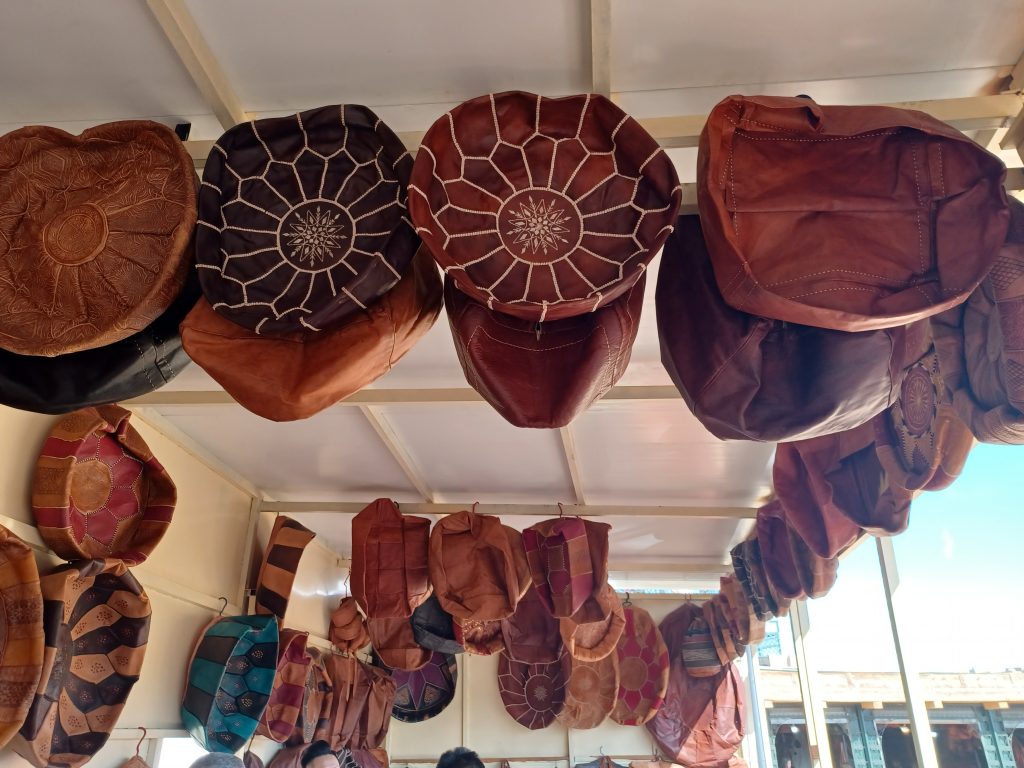
Our Danish group member is measured up for a leather jacket. Tailor made and delivered to the hotel. All part of the service. The leather comes from various animals: sheep, cow, goat and camel.
Stench of the tannery still in our nostrils, we are led the way via various alleyways to a restaurant, our lunchtime stop. Intricate stucco décor within and a unisex toilet.
Bou Inania Madrassa
Following a leisurely lunch, we visit the Bou Inania Madrassa, a religious school, built by the Marinid dynasty in the fourteenth century and restored last century. There is a mosque inside the madrassa but we are only permitted to see the courtyard and the students’ accommodation. The main courtyard has a marble fountain in the middle and is decorated with the intricate mosaic tilework, zellij, in geometric patterns, carved wood and stucco. We marvel awhile. Venturing upstairs, we view the small rooms comprising the students’ digs. Cedar woodwork, tile floors and bronze lamps.
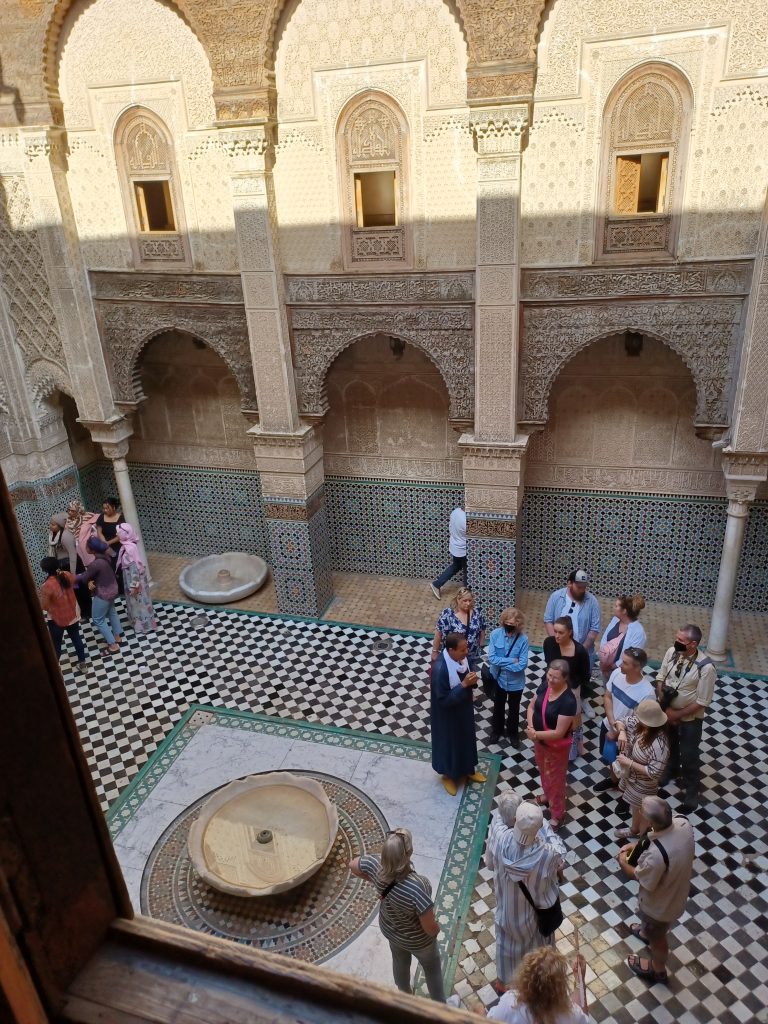
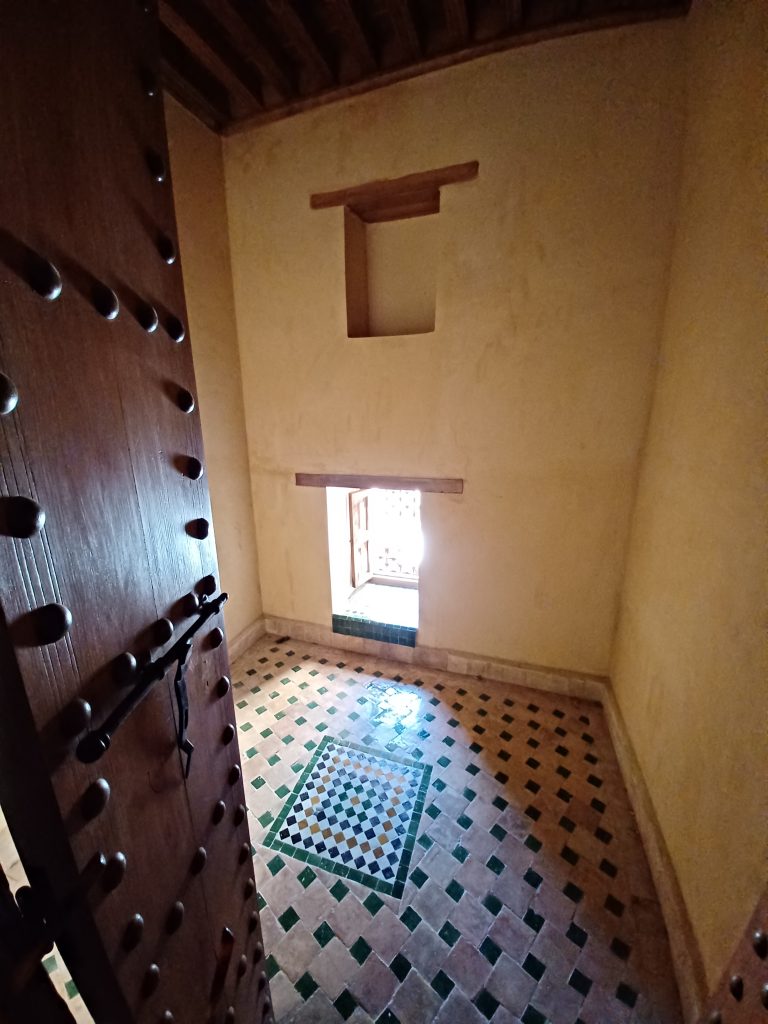
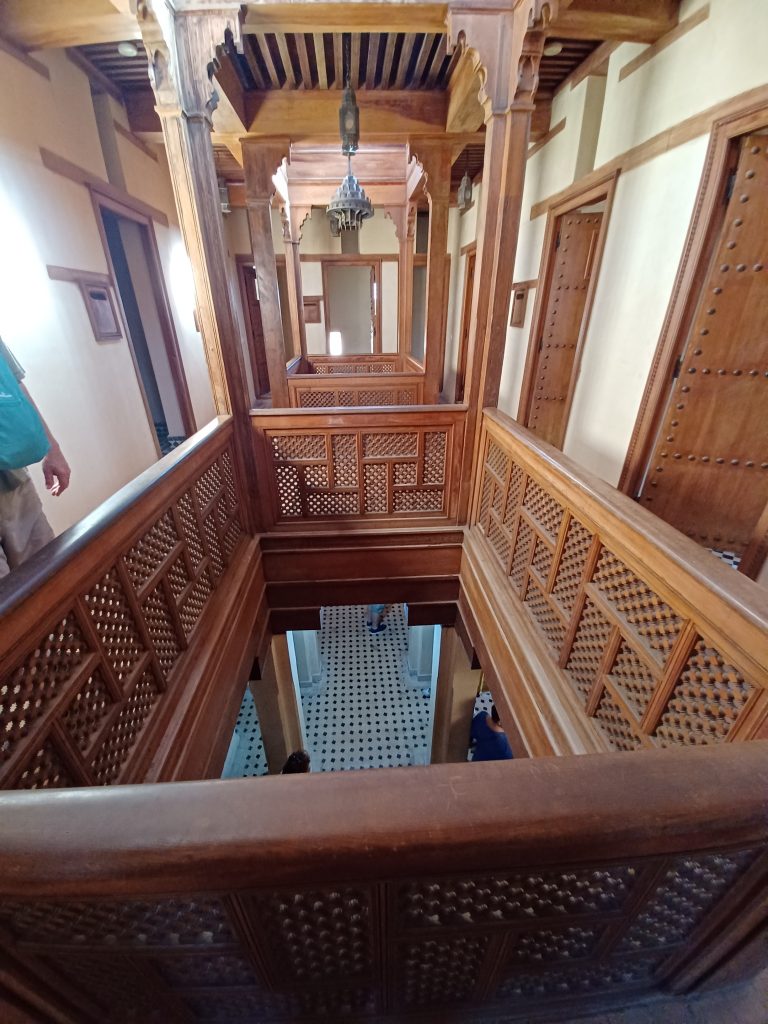
Dinner in Fez this evening is in one of the old palaces which has been converted into a restaurant. Musical entertainment, much enjoyed by all. Couscous, tagines, wine…
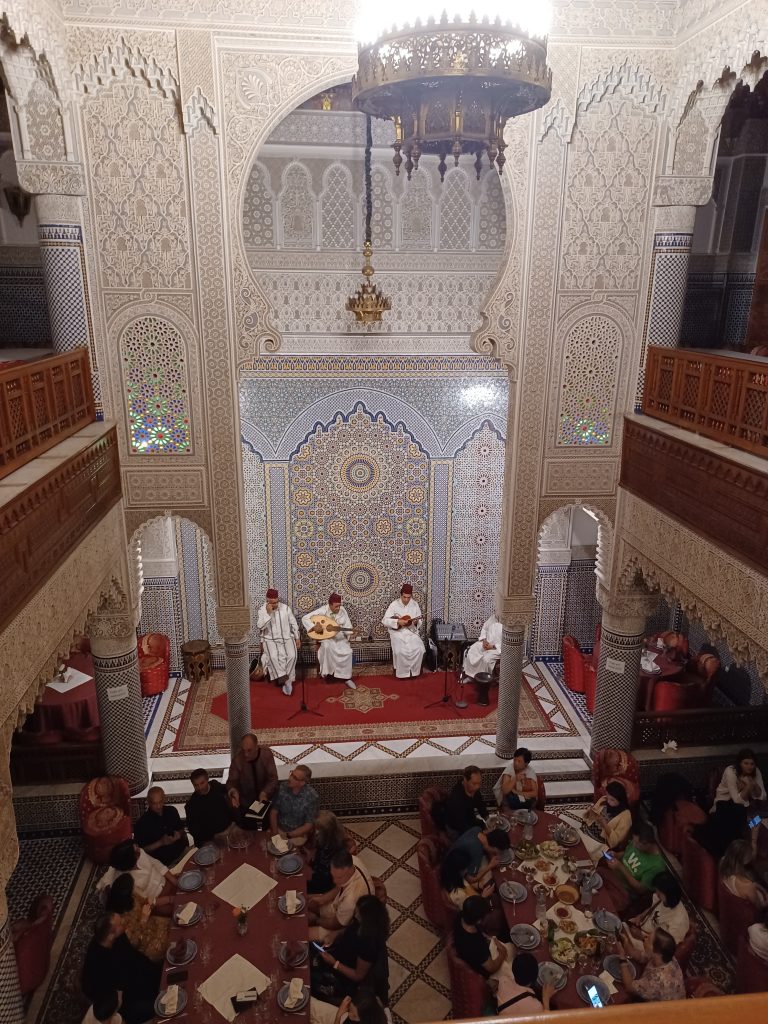
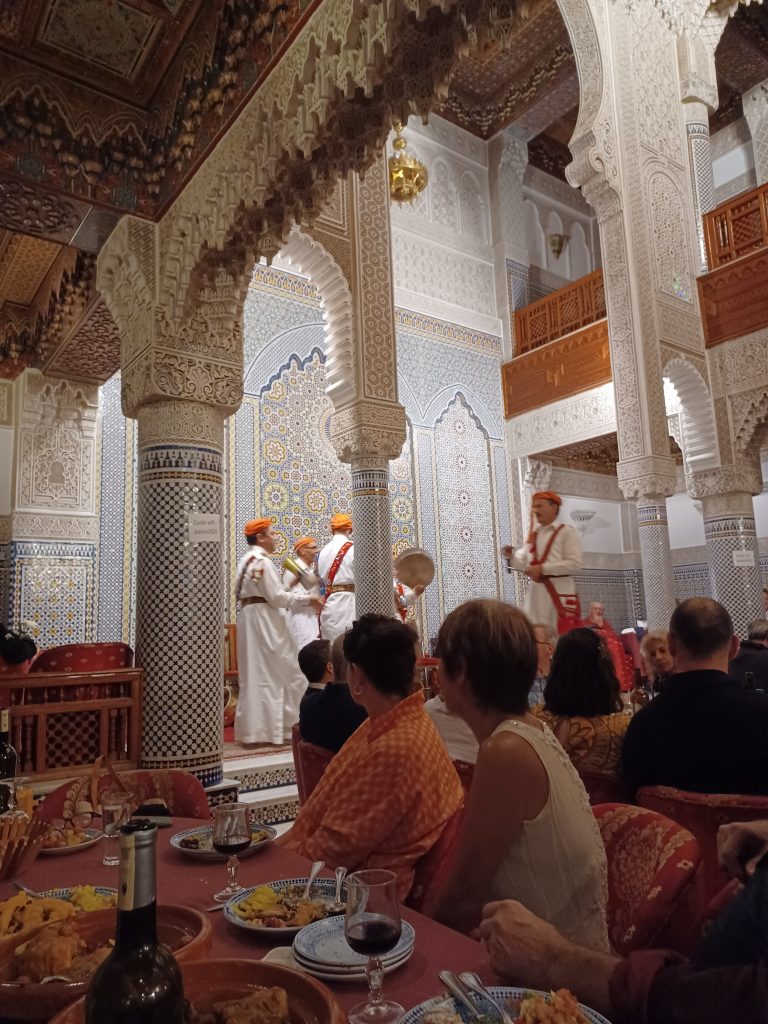
The High Atlas
The charms of Fez are left behind as we head towards Berber country in the High Atlas. The scenery is changing as we ascend the hills with green colours and dark earth and cedar wood trees. At the side of the road are Berber macaques and we alight briefly to watch them. This area is a centre for apple growing, such as Golden Delicious and, on entry to Midelt, perching prominently, is a large apple in the middle of the round-a-bout.
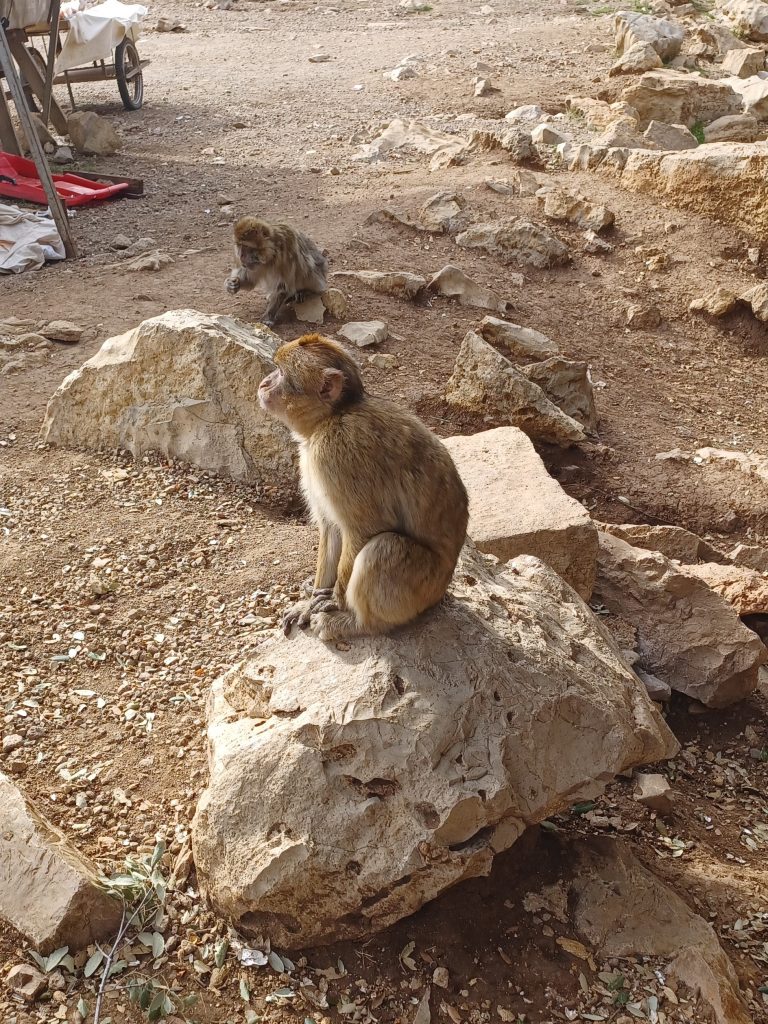
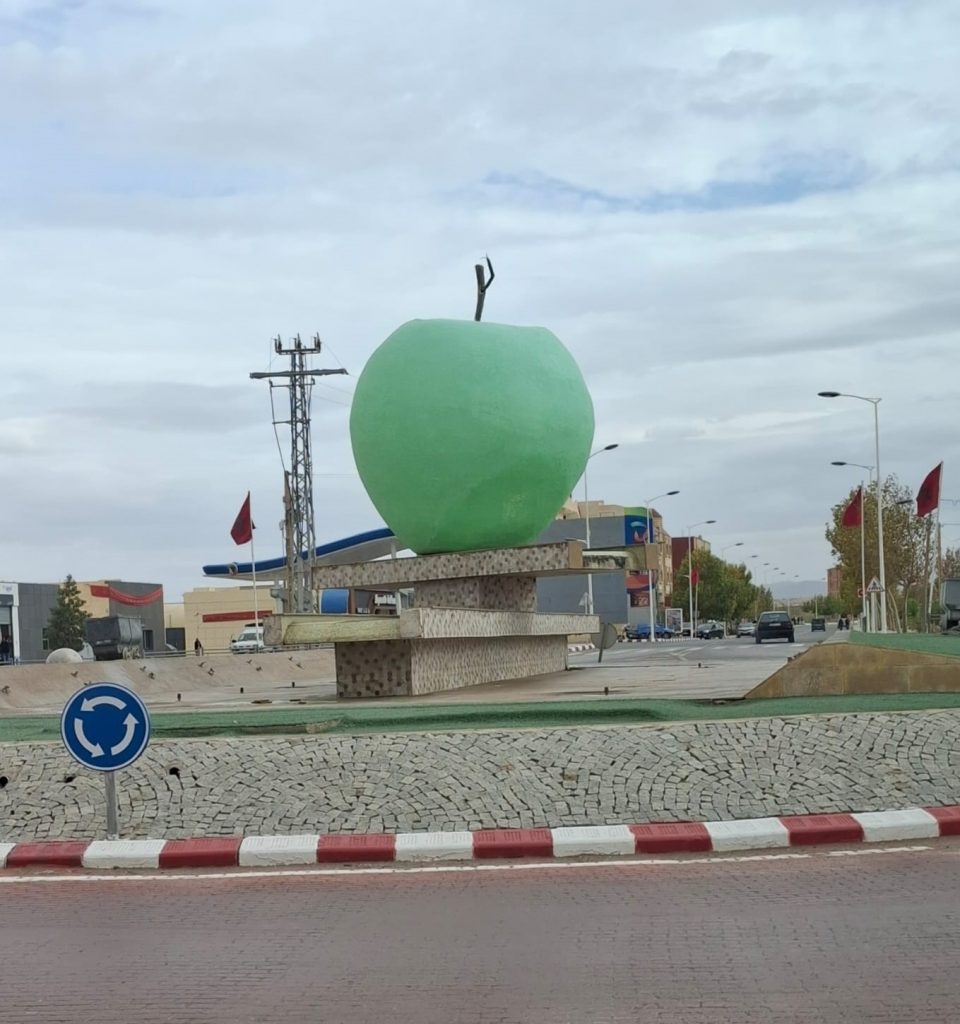
The High Atlas hosts many small villages, their focal points being the mosques with their ornate minarets poking above the houses. The tour company has some kind of relations with one of these Berber villages, and contributes to their income by abstracting money off each tourist. Hence visiting the village. The bus drops us on a dried muddy track and we wander by houses made of packed mud, along earthen alleyways, past donkeys, and boys on bikes. One of our group, an Australian, with admirable foresight, has stuffed his pockets full of candy, which he distributes to the youngsters. “Shokran, shokran” “Merci.” Thank you. Lot of collared doves and crows about. We are shown the produce of the village: peaches and figs, apples and quinces in boxes. The season is pretty much over but this is clearly a perfect area to grow these fruits as it is cool. Alfalfa is also grown for fodder, we are told. Snow shimmers on the Atlas mountains in the distance.
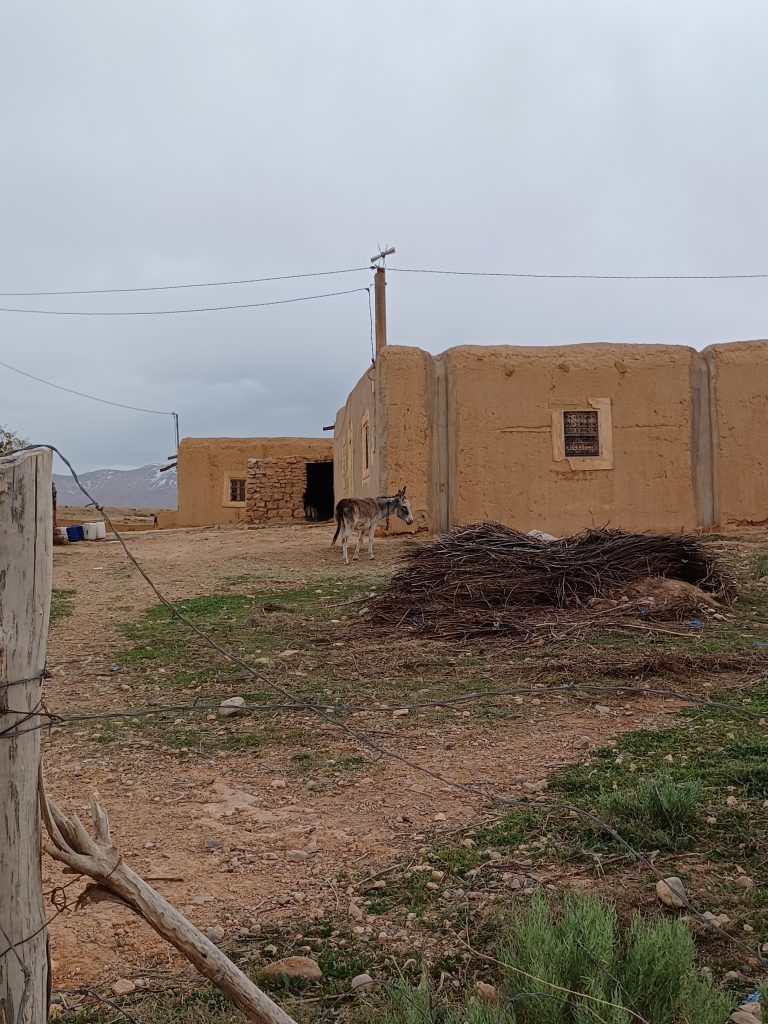
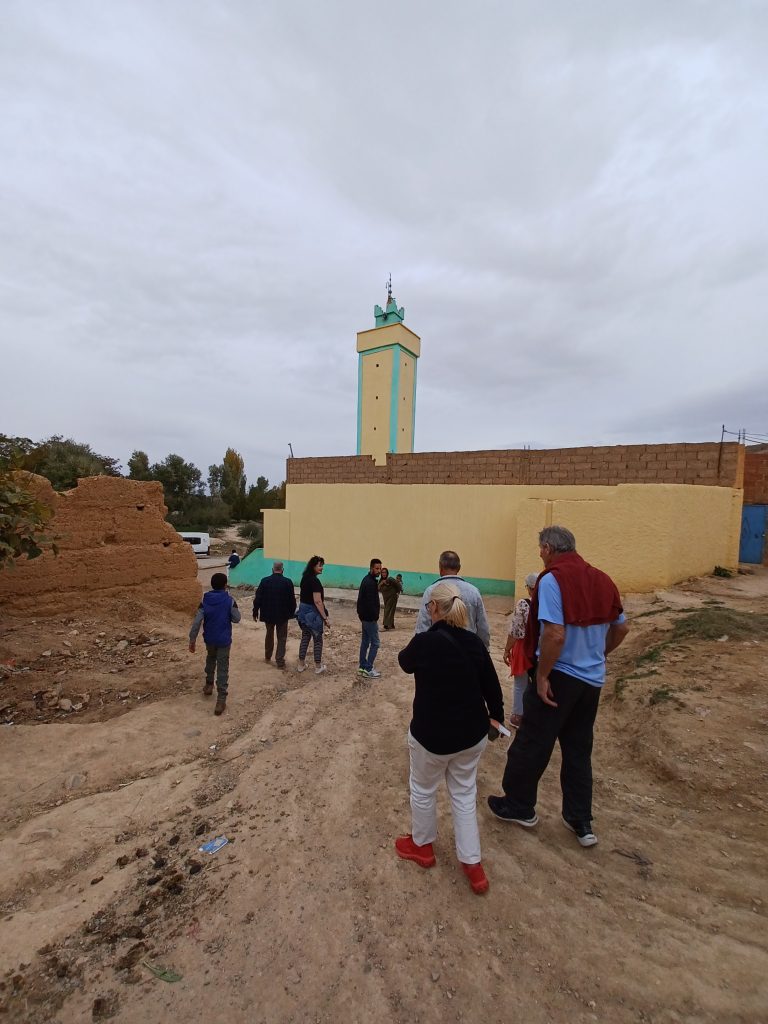
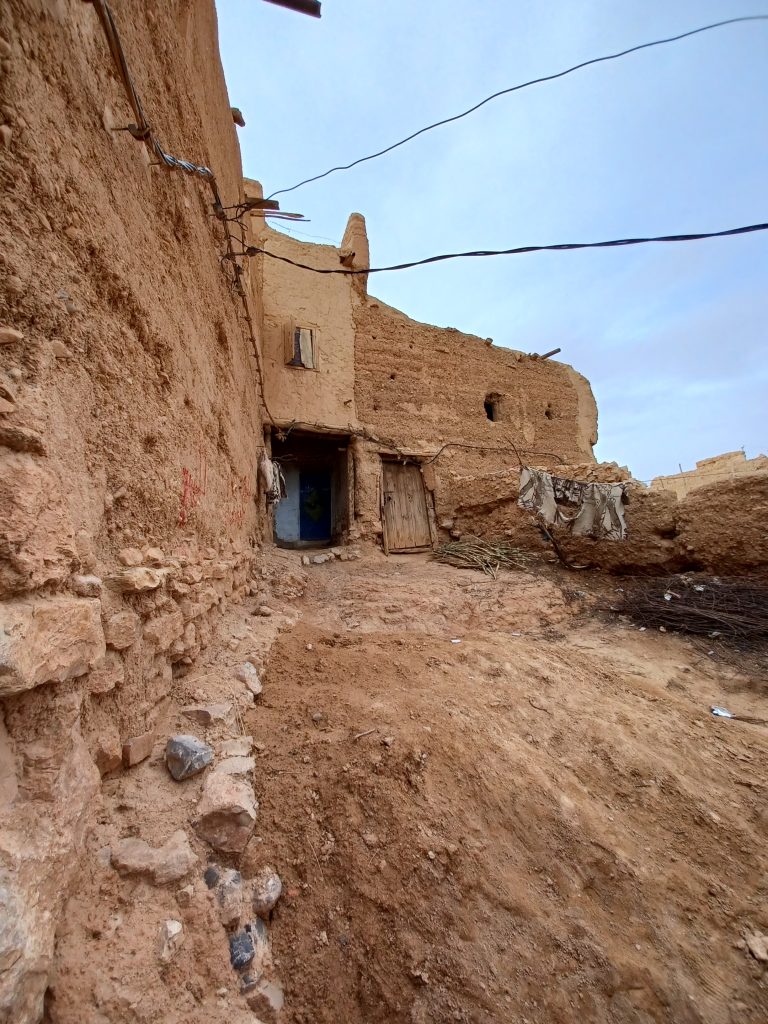
Our guide prepares tea in the central room in the house lived in by a family with five children. We sit round on cushions on the floor where they sleep. Very basic. Someone has produced bread with jam for us, and nuts. No toilet facilities in the house. They perform their ablutions outside somewhere.
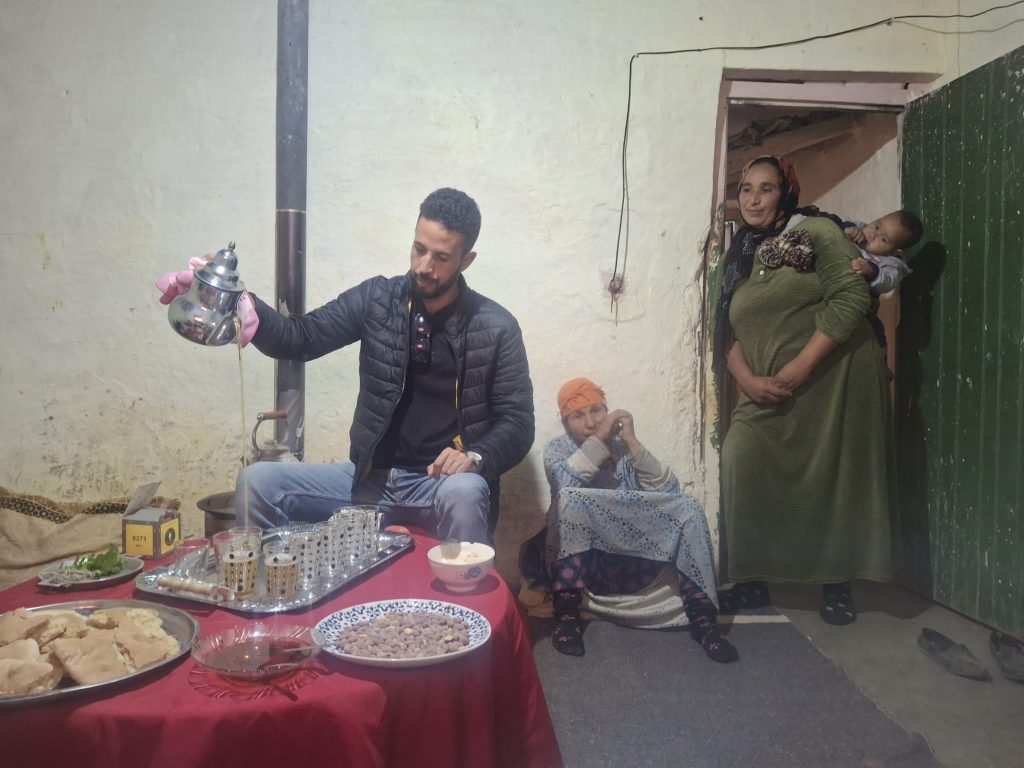
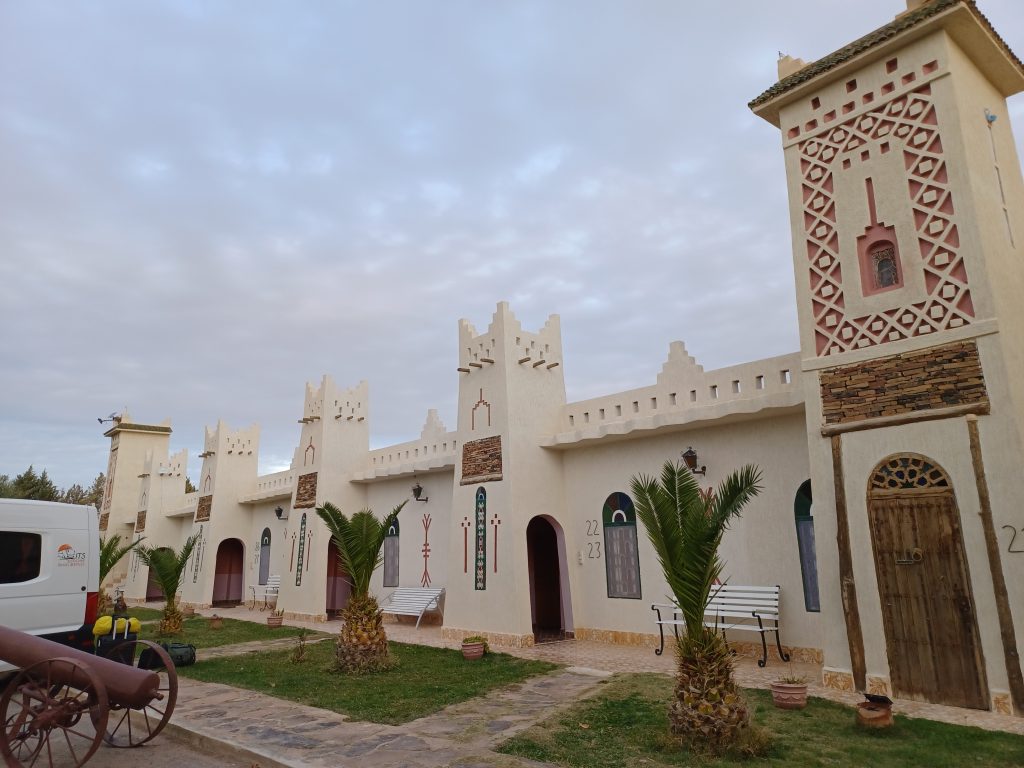
Back to our Moroccan style hotel with an old cannon in front. Lovely room with striped bedspread and floor tiles. En suite. Radiator is on keeping its occupant warm. It is cold outside. Splendid dinner with vegetable soup, turkey kebabs and Moroccan wine. The contrast could not be much greater. Food for thought.
The following day sees us continuing our route southwards across the High Atlas. This is also nomad country and many nomads with their flocks of sheep or black goats are to be seen. The word ‘nomad,’ we area told, stems from the Numidians, an ancient Berber people, who grazed their flocks of sheep and goats in north Africa. We are to pass many more flocks although there are less of them now than in times past. The rocks here are volcanic, very old, and are strewn everywhere. This makes it hard for the flocks to find anything to eat. Temporary nomad camps appear occasionally, surrounded by rubbish. “The nomads move to the Sahara in the winter as the Atlas mountains are too cold”, our guide tells us. The wadis are dry, as we have witnessed in several places, due to the drought. All rather stark and uninviting.
Gorges de Ziz
We gradually descend from the High Atlas along tortuous roads, conducive to queasiness, and into the Gorge de Ziz. The Ziz valley is full of palm trees. Showing that we are lower down now. “Palms don’t grow at high altitudes”. This is more like it. A peachy hotel provides lunch. Fabulous buffet with couscous, meats and vegetables, soft dates, pomegranates and grapes. Find a table underneath a date palm and indulge. Overlooking a pool. An oasis indeed.
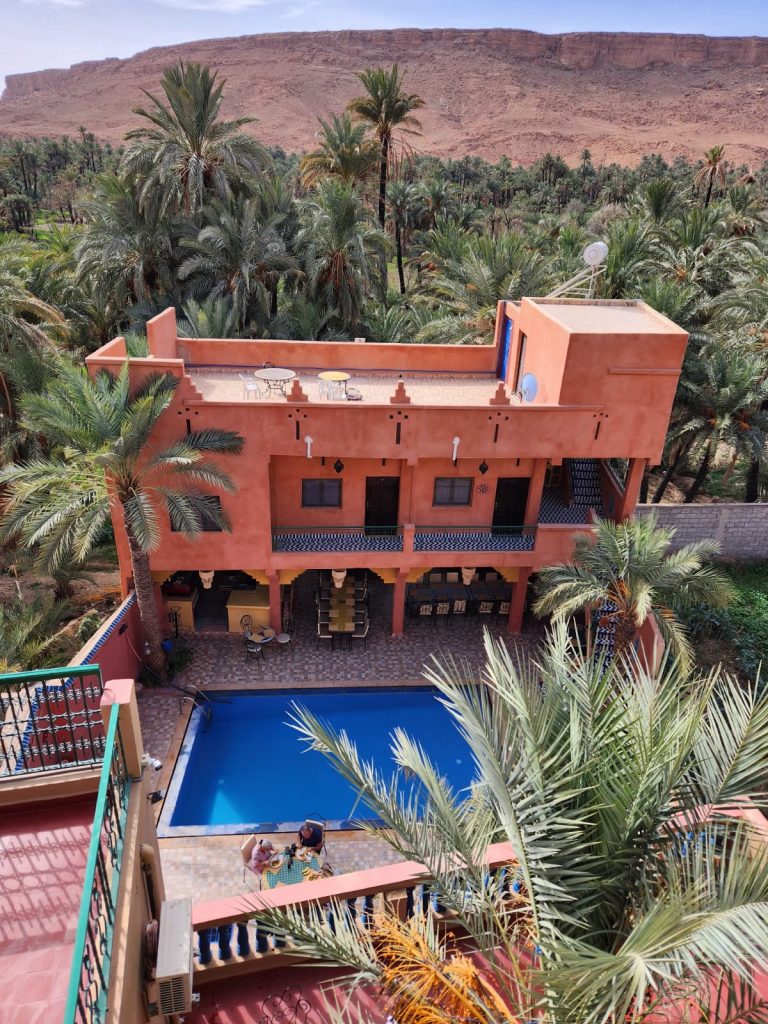
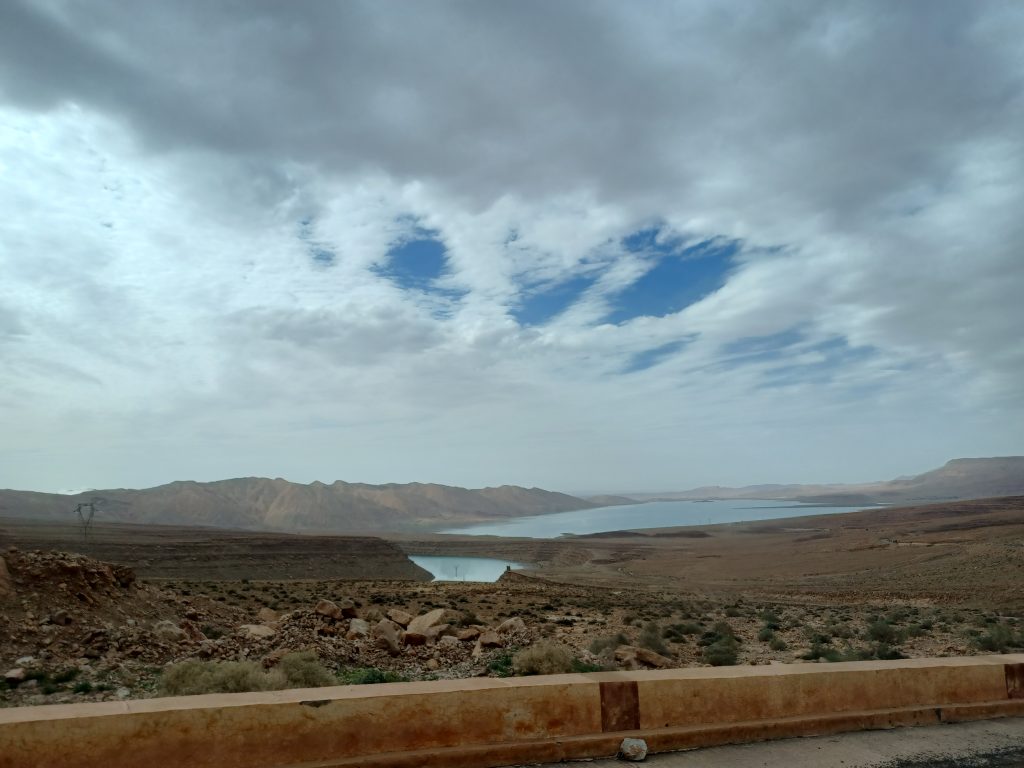
After luncheon, we resume our route through the Ziz gorge. Actually there is a series of deep gorges, once forming part of the caravan trading route from Fez. High cliffs rear up one side of the road with the gorges below. There is some water in the river today, ending at the Hassan Addakil dam and lake.
“The Ziz river used to run into the Sahara and dry out”, we are told. Hence it was dammed here. We are now just north of Errachidia, “named after Rachid, one of Hassan II’s sons”. Useful to know. And south of the High Atlas where the Sahara Desert begins. Fossils are bountiful in this area. As we approach Erfoud, we are asked “Anyone want to visit the fossil exhibition?” Absolutely! We enter the precincts of a large building stuffed full of fossils. The local guide tells us that the underlying rocks of this area are limestone, which was once under the sea. It is one of the world’s richest fossil regions, and the industry: mining, trading etc. is worth a significant amount of cash to the Moroccan economy.
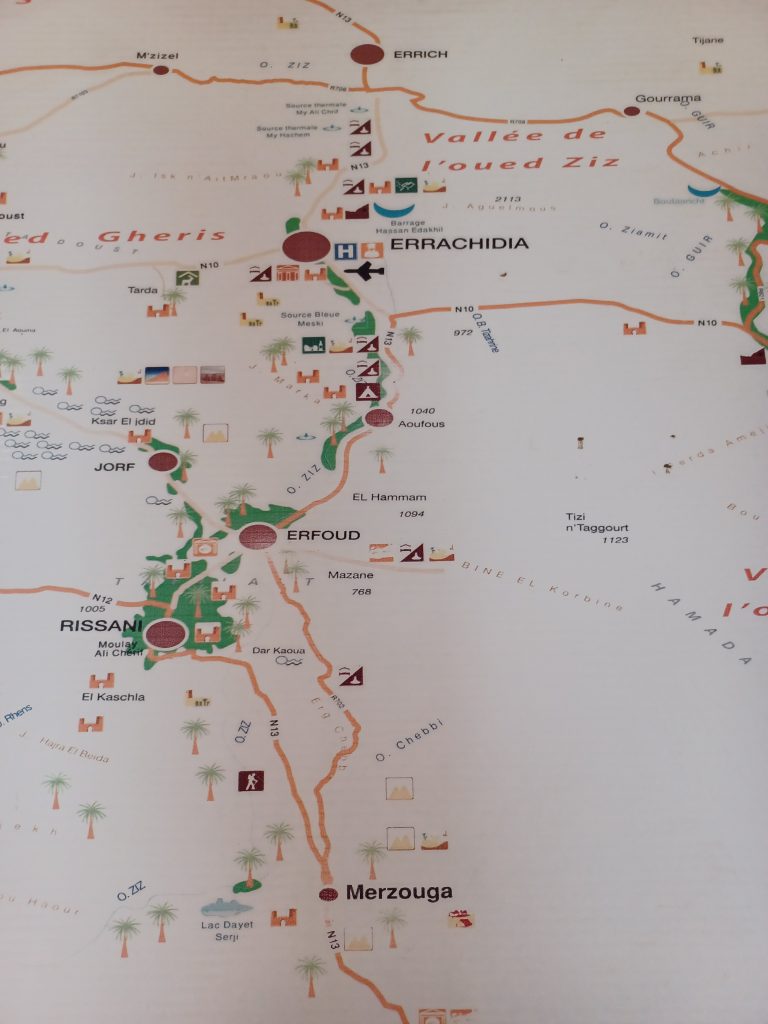
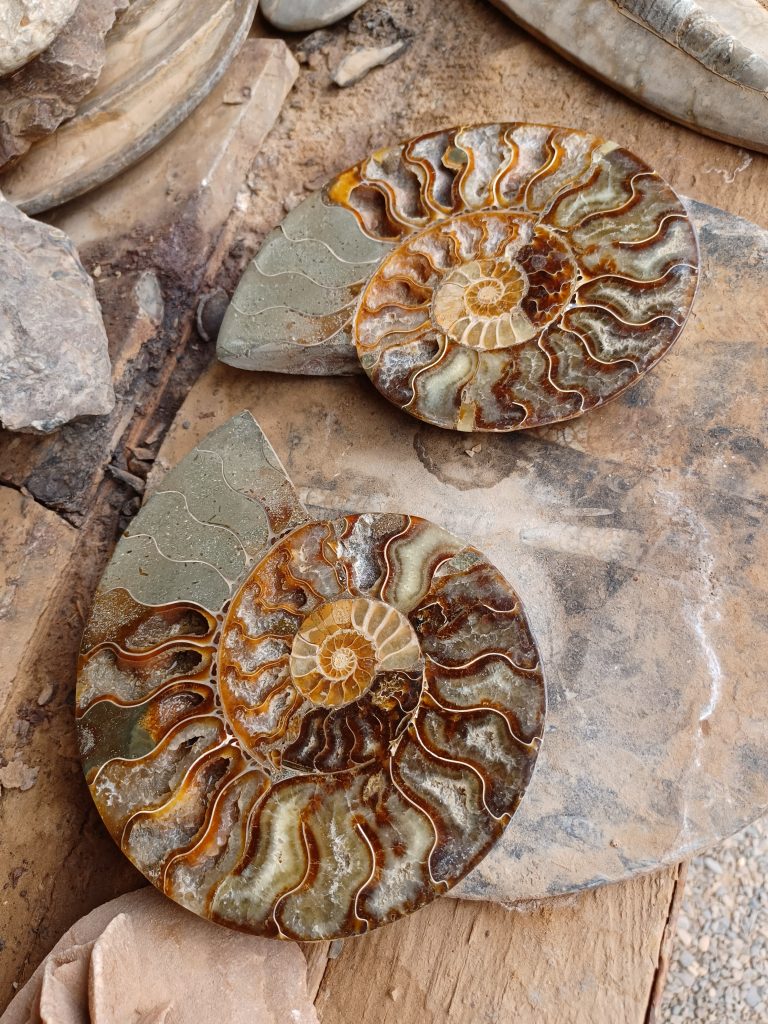
Lot of information throughout. Learn about ammonites (spiral type cephalopods); crinoids or sea lilies (feather stars without stalks); trilobites and orthoceras, among others. The artisans slice the fossils in cross section and polish them. And sell some to travellers of course. Not my field of expertise but it may soon be my daughter’s, currently studying palaeobiology. No doubt she will welcome a couple of polished ammonites to add to the growing collection.
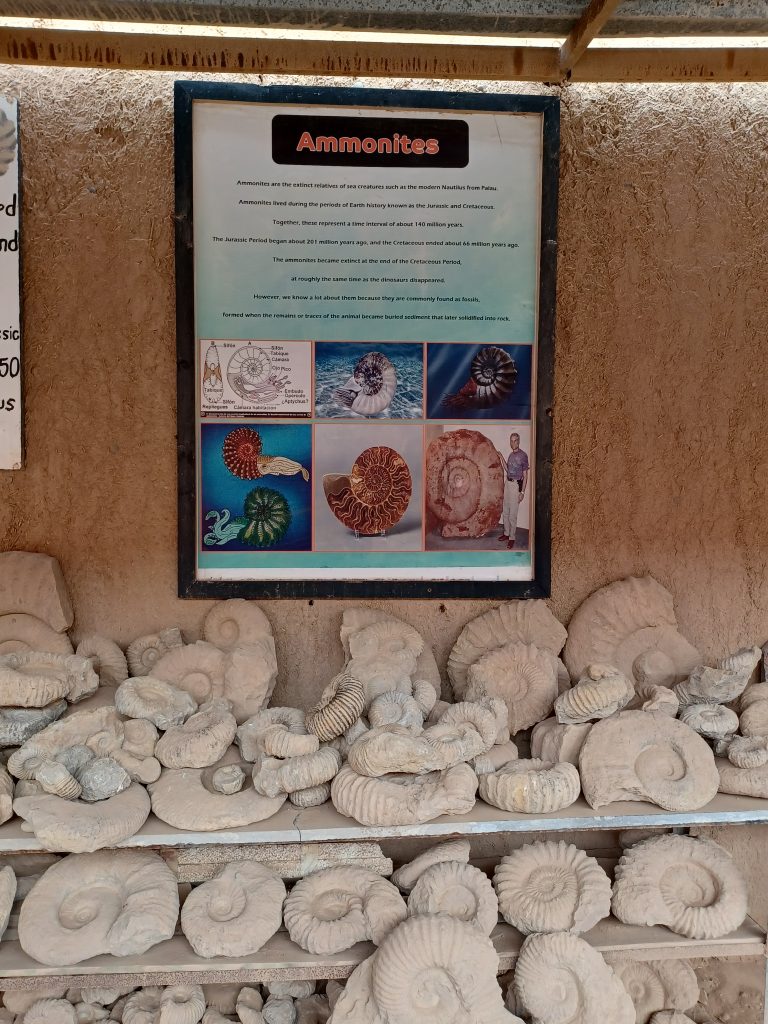
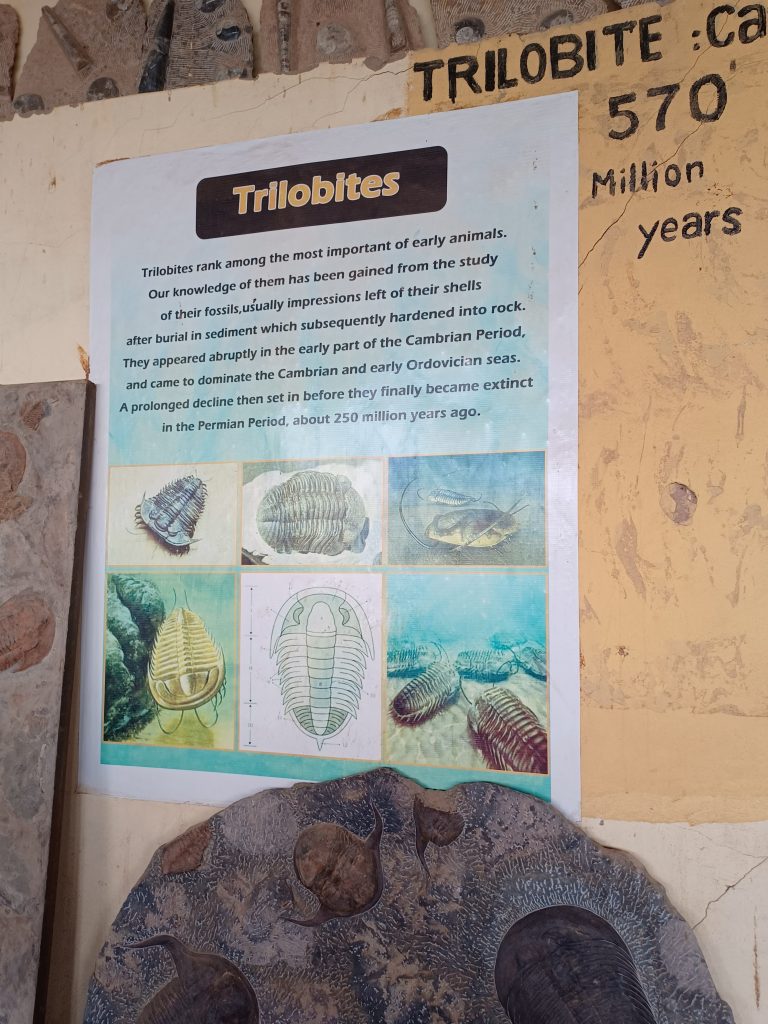
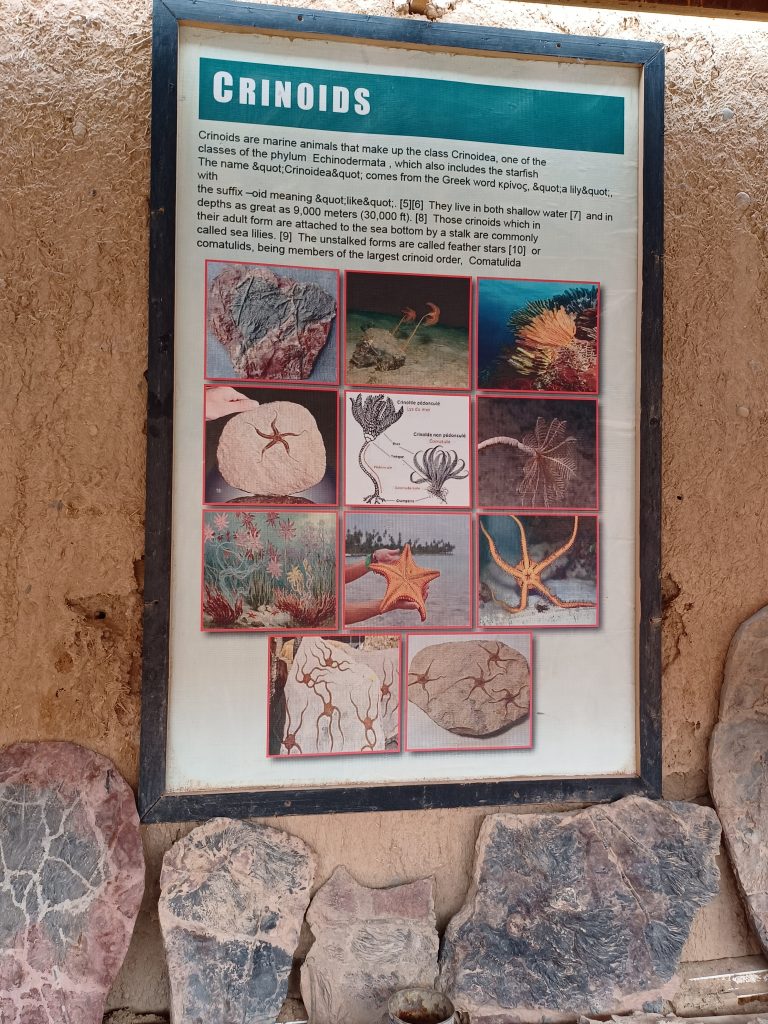
Shopping over, the sand dunes of the Sahara beckon. Off to Merzouga.

Leave a Reply